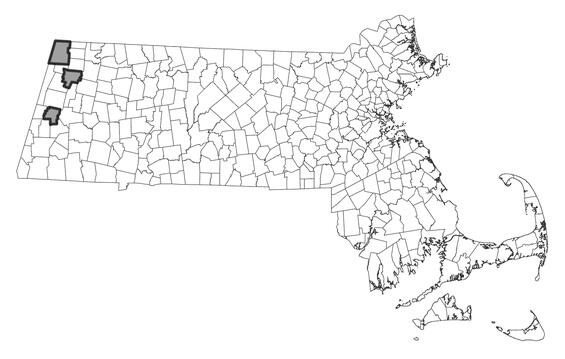- Scientific name: Galium boreale
- Species of Greatest Conservation Need (MA State Wildlife Action Plan)
- Endangered (MA Endangered Species Act)
Description
Northern bedstraw (Galium boreale) is an erect perennial herb in the madder family (Rubiaceae), up to 90 cm (3 ft) tall. It grows in moist, open habitats and is most conspicuous in June and July when its panicles of small, white flowers are in bloom.
Bedstraws (Galium spp.) are generally easily recognized by their multiple whorls of untoothed leaves. Their small flowers have four (three in a few species) petals and no sepals, and they bear dry fruits consisting of two, more-or-less spherical, one-seeded parts. In northern bedstraw, the leaves are 1.5-4.5 cm (0.6-1.8 in) long, lance-shaped (narrow; widest near the base), have three prominent veins, and are always in whorls of four. The stems are erect and, like the leaves, hairless, except for tufts often occurring just below the nodes (points where the leaves attach). The numerous white or slightly cream-colored flowers are 3.5-7 mm (0.14-0.28 in) across. In this species the fruits are 2 mm (0.08 in) wide and may be smooth or covered with short, unhooked hairs.
Eighteen other Galium species are recorded from Massachusetts, thirteen of which are native. There are three other hairy-fruited species with leaves in whorls of four: Hairy bedstraw (G. pilosum), wild licorice (G. circaezans), and lance-leaved wild licorice (G. lanceolatum). None of these have white flowers, and all three have fruits with hooked bristles and grow in dry woods rather than in moist habitats. Five other smooth-fruited species can have leaves in whorls of four, but all of these have weak, more or less sprawling stems, not erect ones as in northern bedstraw, and their leaves tend to be widest toward the tip rather than near the base. Their flowers are no more than 4 mm (0.16 in) across, and most have leaves no more than 2 cm (0.8 in) long (up to 3 cm [1.2 in] in Blunt-leaved bedstraw, G. obtusum).
Life cycle and behavior
This is a perennial herb.
Population status
Northern bedstraw is listed under the Massachusetts Endangered Species Act as endangered. All listed species are protected from killing, collecting, possessing, or sale and from activities that would destroy habitat and thus directly or indirectly cause mortality or disrupt critical behaviors. MassWildlife’s Natural Heritage & Endangered Species Program has 8 records from 4 counties: Berkshire, Hampden, Middlesex, and Norfolk. 3 of these records have been observed within the last 25 years.

Distribution in Massachusetts. 2000-2025. Based on records in the Natural Heritage Database.
Distribution and abundance
This species is circumboreal. It is found throughout much of Canada and the U.S. but is absent from the southeastern states.
Habitat
According to Gleason and Cronquist (1991), northern bedstraw occurs in “a wide variety of not too dry habitats.” However, the known populations in Massachusetts are all in open calcareous fens or wet meadows, growing among species such as grass-of-parnassus (Parnassia glauca), yellow sedge (Carex flava), and shrubby cinquefoil (Dasiphora floribunda).
Healthy habitats are vital for supporting native wildlife and plants. Explore habitats and learn about conservation and restoration in Massachusetts.
Threats
Since it grows in open habitats, northern bedstraw may be threatened by shading or competition due to natural succession or invasions of exotic plants.
Conservation
Sites should be monitored for these changes, and selective cutting of trees or removal of invasive species may be appropriate. All active management of rare plant populations (including invasive species removal) is subject to review under the Massachusetts Endangered Species Act and should be planned in close consultation with MassWildlife’s Natural Heritage & Endangered Species Program.
References
Dale, A., and T.T. Elkington. 1984. Distribution of clones of Galium boreale L. on Widdybank Fell, Teesdale. New Phytologist 96: 317–330.
Contact
| Date published: | April 29, 2025 |
|---|